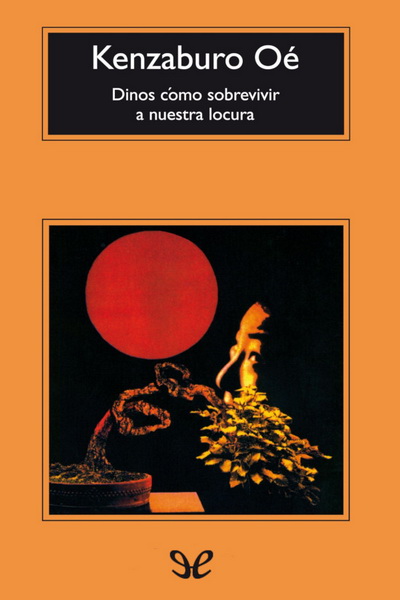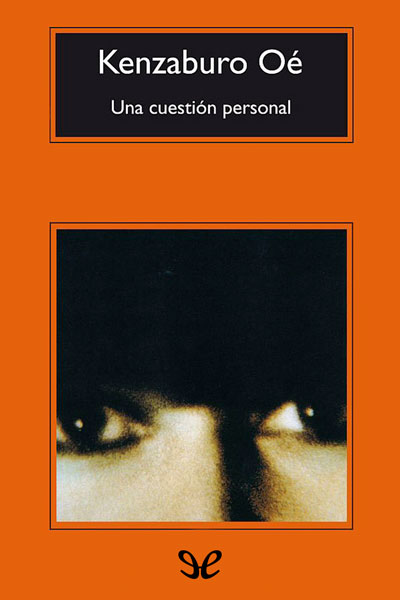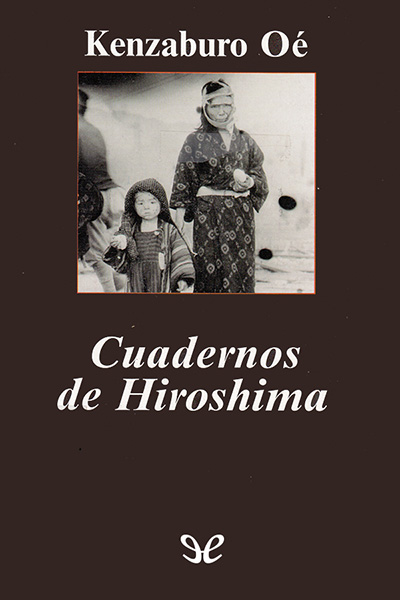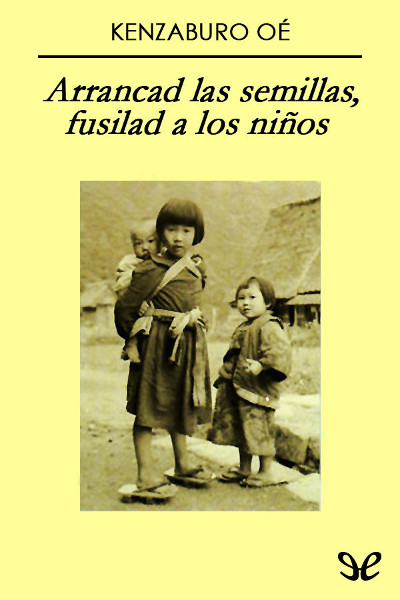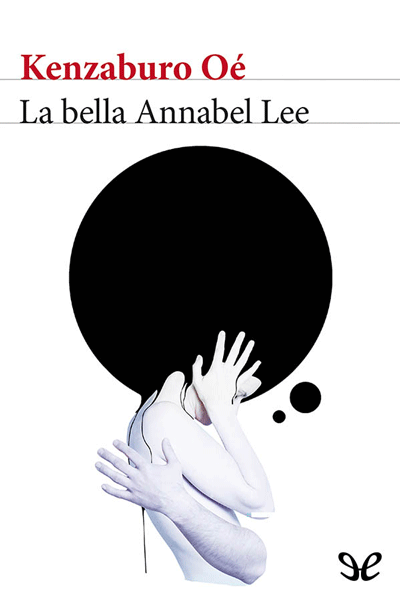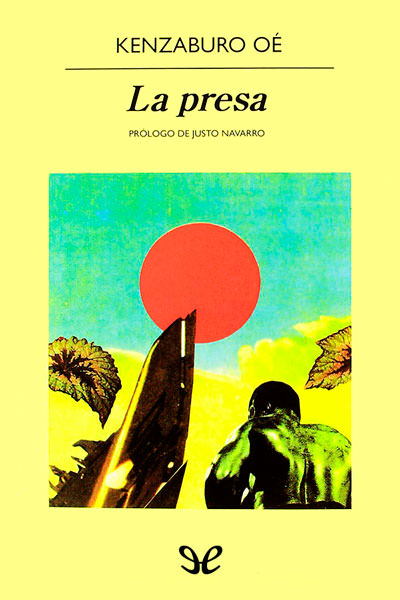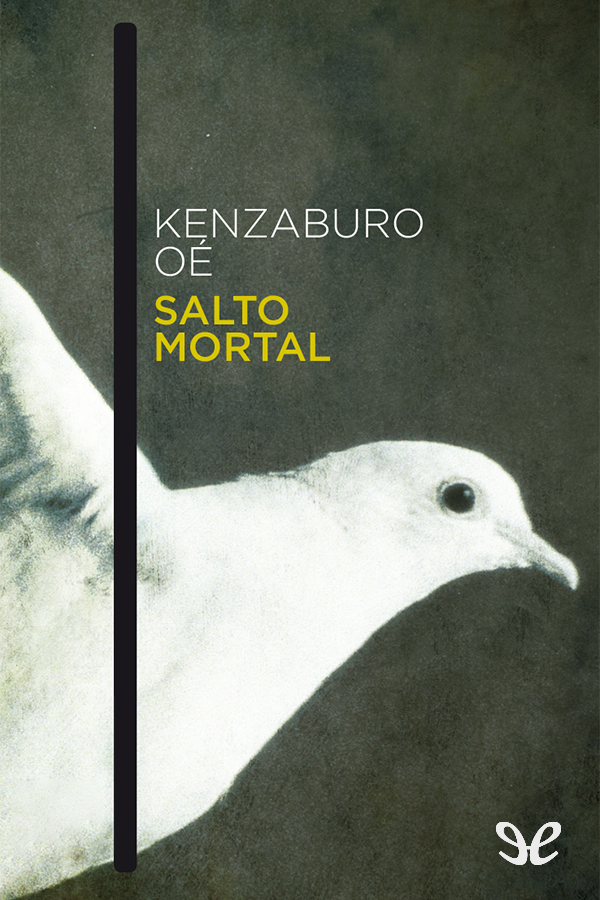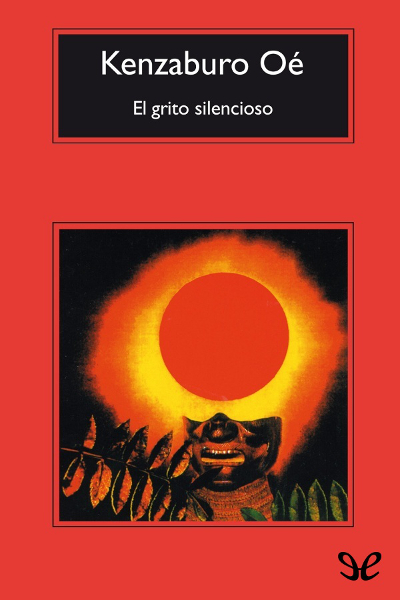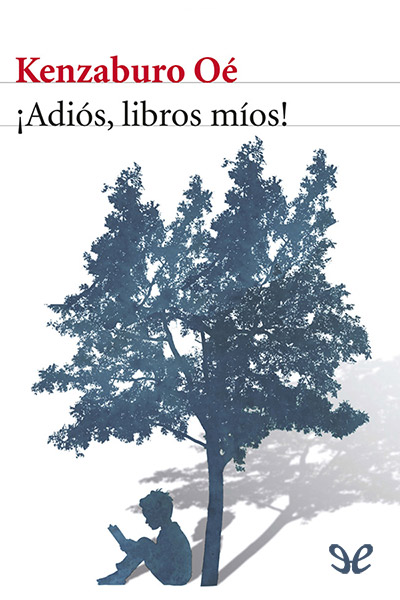oleebook.com
L'animale d'allevamento de Kenzabur? ?e
de Kenzabur? ?e - Género: Italian
Sinopsis
In un villaggio del Giappone affamato dal secondo conflitto mondiale, un aereo si schianta al suolo e un soldato americano di colore è fatto prigioniero. Confinato un un sotterraneo, le caviglie legate con la catena di una trappola per cinghiali, l'uomo diventa l'idolo dei bambini, il loro animale domestico, un nuovo compagno di giochi. Quando le leggi della guerra infrangono l'idillio e l'innocenza è spazzata via dalla violenza della morte, il piccolo protagonista - io narrante di questo sapiente racconto - si affida all'emancipazione dell'età adulta.
Libros Recomendados - Relacionados
Reseñas Varias sobre este libro
November 2015
Hiroshima Notes is written by the 1994 winner of the Nobel Prize for Literature, so I was very excited to read his account of the Hiroshima bombing, convinced that this was an essential work.
The book consists of essays Kenzaburo Oe wrote about his visits to Hiroshima (1963-1965).
On his first journey to Hiroshima August 1963, the author arrives in the Peace Memorial Hall and is at a loss about what to do. So he begins telling about the preparations of the Ninth World Conference against Atomic and Hydrogen Bombs. About the Chairman, the managing directors and the regular directors of the board of directors of the Japan Council against Atomic and Hydrogen Bombs. About the problems and underlying politics of the world conference (confrontations between the groups mobilized by the Japan communist party and the Japan socialist party). About the local Hiroshima Council against A- and H-bombs. About the speeches given at this World Conference. Very very boring.
In Chapter Two : 'Hiroshima Revisited August 1964', the author writes in detail about the peace movement and the peace conferences, again. I really struggled to finish the second chapter.
I'm now on page 78, and I really dis this book. It's not at all what I expected, and certainly not essential reading, unless you're a peace movement activist or a politician living in Hiroshima.
February 2016
I decided to pick this up again, and I'm glad I did.
The book becomes more interesting in the second half, at least if you are open-minded enough to get into philosophical and psychological considerations (sometimes rather obscure) of humanitarian nature. The author's observations and insights are at times powerful and transcendent, and I begin to understand why the author was honored with the Nobel Prize for Literature.
In Chapter 3 : "The moralists of Hiroshima", the author explains why he regards the victims of the A-bomb as moralists, as 'interpreters of human nature' ; why they have unique powers of observation and expression concerning what it means to be human.
This observation is certainly something to think about. Do people have to undergo great tragedy to become experts on human nature? This is a rather depressing thought. I'd to believe it's only a certain degree of wisdom. To understand what it is to be human is so much more.
But It could be the explanation for why me and so many of us to read books, non-fiction as well as fiction, about mankind's disasters, and even survival stories in general. We praise ourselves lucky not to have to experience such tragedies but we to read about it anyway. Do we hope to share, even obtain, something of this unique wisdom by reading these kind of books?
In Chapter 4, "On Human Dignity", the author reflects on the meaning of 'dignity' versus 'humiliation (or shame)' and the importance of remembering the extremity of human misery that was Hiroshima and to never lose sight of the dignity of its survivors.
Chapters 5 and 6 describe medical relief and the immense difficulties and despair facing the doctors of Hiroshima.
In Chapter 7 and in the Epilogue, more accounts of the sufferings of Hiroshima's victims are given and the conclusion that "Being their comrades becomes the only way we can remain true human beings".
Throughout his book, the author urges for more exposure of the Hiroshima tragedy. After the war, the occupation forces did not want the world to know the A-bomb realities. Testimonies that depicted this too vividly were suppressed and consequently buried deep in the storeroom of Hiroshima City Hall.
"To put the matter plainly and bluntly, people everywhere on this earth are trying to forget Hiroshima and the unspeakable tragedy perpetrated there. We naturally try to forget our personal tragedies, serious or trifling, as soon as possible (even something as petty as being scorned or disdained by a stranger on a street corner). We try not to carry these things over to tomorrow. It is not strange therefore, that the whole human race is trying to put Hiroshima, the extreme point of human tragedy, completely out of mind... All who fortunately survived, or at least luckily suffered no radiation injury, seek to forget the ones who, even now, are struggling painfully toward death. Forgetting all these things, we go on living comfortably in the crazy world of the late twentieth century.
In October 1964, when a young man born in Hiroshima on the A-bomb day was selected as the last runner to carry the Olympic flame, an American journalist ... publicly stated his opinion that this was an unhappy choice because it reminded the Americans of the atomic bomb." (p. 107)
"Do not all leaders and people who at present possess nuclear weapons also wish to erase Hiroshima from their memories? ...
Powerful leaders in the East and in the West insist on maintaining nuclear arms as a means of preserving the peace. ... But it is obvious that all advocates of usefulness base their opinions on the power of nuclear arms. Such is the fashion and common sense of today's world. Who then, would want to remember Hiroshima as the extremity of human misery?" (p109).
Would I recommend this book to anyone?
Even though I feel satisfied to have read it and some parts of it are powerful and thought-provoking, I would not recommend it because I think it was not a very accessible work and maybe not meant to be read by a general public. No doubt it has a great value for specific groups, e.g. for the Japanese political and medical society and for peace-movement activists.
I would rather recommend Black Rain (Masuji Ibuse) or Hiroshima (John Hersey).
The manga series "Barefoot Gen" is also a great read about the bombing of Hiroshima and its aftermath ( an excellent review from Bruce )
Also, both "Black Rain" and "Barefoot Gen" are made into excellent movies which I can recommend wholeheartedly.
"The picture of Hell. Throughout human history, people have had various nightmarish visions of the end of the world... People could believe that the end of the world would be experienced as having some kind of human shape and name.
But when radioactivity destroys human cells and alters human genes, any living beings of the future would be no longer human but something grotesquely different. This scenario of the world's end is the most dreadful and sinister yet. What happened in Hiroshima (twenty) years ago was an absurdly horrendous massacre; but it may be the first harbringer of the world's real end, in which the human race as we know it will be succeeded by beings with blood and cells so ruined that they cannot be called human. The most terrifying monster lurking in the darkness of Hiroshima is precisely the possibility that man might become no longer human. " (p.182)
4/10japan owned-in-english47 s Paul FulcherAuthor 2 books1,470
In 1963, Kenzabur? ?e, then aged 28, was already developing a reputation as a novelist and a spokesperson for the younger generation.
June 1963 marked the birth of ?e's son Hikari, born with a severe brain lesion, who was to be so important to much of the rest of ?e subsequent writing.
Shortly after the birth, while debating whether to consent to an operation that might save Hikari's life but ly leave him mentally handicapped, ?e accepted a commission to visit Hiroshima to report on a international peace conference to abolish nuclear weapons, a gathering that influenced by international trends, was expected to end in serious fragmentation of Japan's peace movement,
The result of that visit was this series of essays, ???????? (phonetically Hiroshima n?to), which was originally published in 1965, between the 1964 novel A Personal Matter and perhaps his masterpiece The Silent Cry on 1967 (titles in the later English translations).
But the experience also had a profound impact on ?e's own work and life:
Without that transforming summer experience, my literary work and my personal life would never have evolved as they did.
(author's introduction to 1995 edition)
(see also https://www.nobelprize.org/prizes/lit... for more background on the author and his works and this Goodreads thread https://www.goodreads.com/topic/show/...)
The opening essays here tell of a Montyphytonesque split in the anti-nuclear movement, largely due to whether disarmament demands should be applied to all parties or somehow exempt the Communist bloc, and also whether Russia and China should be treated differently, leading to a farcical People's Front of Judea/ Judean People's Front "splitter" into the The Japan Council Against Atomic and Hydrogen Bombs and the The Japan Council Against Atomic and Hydrogen Bombs.
But ?e instead found himself impressed by the dignity, and dismayed by the ongoing suffering, of those who actually experienced and survived the bomb (rather than those attempting to use their suffering purely for political purposes).
I have read all of ?e's fiction in English translation, albeit many of the key works (including those discussed by the Nobel Committee https://www.nobelprize.org/prizes/lit...) are as yet untranslated.
But I was prompted to visit this book by Andres Neuman's novel Fractura, based around the Fukashima nuclear incident but whose protagonist, a (fictional) survivor of Hiroshima, reads this work in the 1960s, and can't identify with ?e's view:
Watanabe had been born in the same year as ?e, in a neighbouring region, just one prefecture away. They were both from towns close to Hiroshima, brought up under a militaristic nationalism, but had opposite approaches to dealing with the past.
His near neighbour wrote about the lessons the world could learn from the nuclear tragedy. About respect for the victims. The dignity of the survivors. Or promoted these ideas with the best of intentions.
The problem was that Yoshie himself felt very far from embodying those supposed lessons. He had no sense of being ennobled by everything hed experienced or lost. All he retained, with brutal clarity, was the fear, the harm, the anger, the shame.
?e's own take on the Fukashima disaster can be found in his last (to date) novel whose English title would be In Late Style (from Edward Said's essay collection) but which unfortunately has yet to be translated (see https://web.archive.org/web/201203190... and https://www.lemonde.fr/livres/article...)
It has to be said this book doesn't read that well to a more international audience, either in terms of the detail (things that would have been current issue in 1960s Japan are rather hard to follow in 2020s UK) or it the attitude. The rather infamous line in one of his essays even though the scope of misery caused in Hiroshima far exceeds that of Auschwitz is really quite a shocker (why even quantify a comparison?) albeit technically he is reporting (albeit approvingly) someone else's views.
In his 1995 foreword ?e acknowledged:
At the time of writing these essays in this book I was sadly lacking in the attitude and ability needed to recast Hiroshima in an Asian perspective.
something he attempted to rectify in his 1994 Nobel Prize lecture (https://www.nobelprize.org/prizes/lit...)
The contemporary state of Japan and its people in their post-modern phase cannot but be ambivalent. Right in the middle of the history of Japan's modernisation came the Second World War, a war which was brought about by the very aberration of the modernisation itself. The defeat in this War fifty years ago occasioned an opportunity for Japan and the Japanese as the very agent of the War to attempt a rebirth out of the great misery and sufferings that were depicted by the Post-war School of Japanese writers. The moral props for Japanese aspiring to such a rebirth were the idea of democracy and their determination never to wage a war again. Paradoxically, the people and state of Japan living on such moral props were not innocent but had been stained by their own past history of invading other Asian countries. Those moral props mattered also to the deceased victims of the nuclear weapons that were used for the first time in Hiroshima and Nagasaki, and for the survivors and their off-spring affected by radioactivity (including tens of thousands of those whose mother tongue is Korean).
Also as fan of the author's novel, this was disappointing on a purely literary level, albeit that may well be a function of the translation. This book is aimed in English at a different audience and with a different literary intent, that his novels, and the translation decisions by David L. Swain and Toshi Yonezawa (not the translators of his novels) rather reflect that. As the former explains in a foreword:
The editorial goal was to make the author's own text as accessible as possible to the English-language reader ... the author's intricate style at times lends itself to both complex and simple English translations and editors opted for the more straightforward rendering.
As a (frustrated by lack of translations) ?e completist, this was a worthwhile read for background and insight into his writing (and I plan to tackle his autobiographical writing next). But I would struggle to recommend this to anyone who is a fan of the novels but hasn't yet read them all (read the fiction first) or as the best non-fiction treatment of the people of Hiroshima.
2.5 stars202017 s David638 124
I can't see why this was translated; it seems entirely for a Japanese audience. It opens in 1965 with the Japanese Communist Party (Beijing's stooges) and the Japanese Socialist Party (Moscow's) finding it increasingly difficult to work together ... ostensibly they both want to secure "world peace" ... but really it's all just more bullshit about power and I'm not sure why anyone, Oe least of all, should care. Why doesn't he confront this? Is it okay to use A-bomb victims in this way?
In later essays we meet some interesting and brave victims (love suicide always gets a twitch from my Mishima-meter), but I didn't feel that Oe was bringing us anything particularly moving or profound.
And he's ... well ...
"...even though the scope of misery caused in Hiroshima far exceeds that of Auschwitz."
Yeah?
Then:
"The campaign for a white paper on the A-bomb damages and casualties is one important way to make the human misery of Hiroshima thoroughly and accurately known to the world, as is Auschwitz's."
This seems wrong. When I was growing up, nuclear holocaust was all we feared. Hiroshima was much better known to me and my classmates ... mainly because, I fear, for white kids in the English countryside, a Hiroshima seemed the most ly to happen to us.
Disappointing.
"I have learned that even if we lose everything, we gain something."
"An atomic bomb doesn't just fall; someone has to drop it."big-red-circle8 s Smiley 776 18
Being a long-awaited Oe book after reading his The Crazy Iris and Other Stories of the Atomic Aftermath (Grove Press 1994) in August 2013, it was one of the paperbacks I delightfully bought at Kinokuniya, Sapporo Branch last July. However, I found this 7-chapter powerful statement (back cover) regarded as his essays a bit less enjoyable than the one aforementioned because of its different genre. Generally, the book depicting short stories on a theme from various writers tend to be more readable than this one presenting essays but there are also readers who may prefer reading good essays as well.
While reading this book copyright in 1965, two decades after Hiroshima was devastated by the atomic bomb, I wondered what we could learn from his ongoing statements in which, I think, were a bit tough to reflect and write to the world to read and share the ultimately horrific fate of Hiroshimas people, infrastructure, environment, etc. Interestingly, we can see Oe has willingly narrated from his objective viewpoints as witnessed, shared and observed by his contacts with those incurably hopeless victims.
essays japan6 s AC1,798
I thought I might find this one easier to reach than "Who Will Teach Us...", but did not. It consists largely of Oe's reflections on the various incompetencies and hypocrasies of the Peace Movement in Japan c. 1964, along with reflections on the nobility of certain doctors. It is not that interesting. Perhaps this is one of those authors who simply cannot be read in translation or hurriedly.japan6 s Teri709 88
Kenzabur? ?e delivers a very thought-provoking book in Hiroshima Notes. Seven individual "notes"/chapters are compiled to offer the reader a look at life in the aftermath of the Hiroshima bombing that brought an end to World War II. ?e wrote these notes after many visits to Hiroshima in the 60s. He details the rebuilding that was still continuing, the suffering and conditions of victims of the bombings, the men and women who treated and supported the survivors, and the ongoing work to ensure that nuclear weapons will never again bring such an atrocity to the world.
?e offers a perspective that I had never really considered. You don't hear much about the a-bomb/h-bomb survivors. Many suffer in silence. Many blame their own country for putting them in a situation where such an outcome was even considered. A few considered that suicide was the better alternative to suffering through their pain. Even today, the effects are seen in later generations that are born with diseases/conditions that are a direct result of what their parents suffered.
I think this should be required reading for high school and college students studying World War II.hbc-japan read-in-20155 s Lahierbaroja597 161
Sin duda este libro no es un libro amable, simpático o sencillo. Es una historia cruda, llena de dolor y que por desgracia es real. Es un libro atemporal, que trata temas perennes, que nos ayuda a comprender de qué es capaz el ser humano, para bien y para mal, cómo saca fuerzas de flaqueza para continuar viviendo. Y digo atemporal porque hoy podemos comprender la magnitud de nuestra historia, pero dentro de treinta años también podremos (y deberemos) echar la vista atrás para conocer los errores del pasado.
Es un libro molesto pero necesario. Un ensayo triste, tristísimo, que genera rabia y confusión, odio y lágrimas.
https://lahierbaroja.wordpress.com/20...5 s Fábio Shecaira36 2
Readers who are critical of this book seem to be disappointed by the fact that it is not a systematic account of the impact of the A-bomb on the lives of the inhabitants of Hiroshima. Indeed, Oes book is a collection of essays prepared at different times and with different ambitions. Some are more journalistic, others more philosophical. The essays were written between 1963 and 1965, a period during which Oe visited Hiroshima several times. The initial essays focus on the partisan divisions within the anti-nuclear movement in Japan, divisions resulting both from internal political disputes and broader Cold War influences. Oe then turns his attention to the stories of A-bomb victims and medical workers, many of whom he met during his visits to Hiroshima.
One of the most interesting aspects of the book is the way in which it contrasts the various attitudes, from hopelessness to tireless activism, of the people of Hiroshima. The book is also successful in its discussion of the worrisome lack of consensus among the Japanese as to the proper way to react (morally and politically) to the nuclear disaster.
The prose is fairly simple, yet the book is not so easy to understand. The reason for the difficulty is that the essays were originally commissioned for publication in a Japanese journal. So, the text naturally presupposes a considerable amount of information about Japanese politics and society in the 1940s and 50s. The endnotes prepared by the editors do help to fill the knowledge gap, but not completely. One might want to read other books on Hiroshima and the A-bomb before coming to this one. (Herseys Hiroshima, for instance, may be helpful.)
One final critical remark is in order. Although Oe is generally a sensitive and sensible thinker, there is one particular statement towards the end of the book that sticks out a sore thumb: ... the scope of misery caused in Hiroshima far exceeds that of Auschwitz. What do we gain from such a careless and dubious comparison?4 s Mario325 35
Desconocía mucho de esta obra: no sabía quién era el autor, no sabía con exactitud de qué iba la obra, no sabía el impacto, no sabía el contexto, y no sabía muchas cosas más.
Al inicio me perdí entre la politiquería que registra, y los eventos intranscendentales. Pero después, escribe dos magistrales cuadernos que me tomaron desprevenido.
En el primero explora la condición de la dignidad humana, y en el segundo explora la resiliencia de los médicos frente a las secuelas por la bomba nuclear. Con una impresionante narrativa, dolorosa a veces, nos lleva al corazón del sufrimiento humano, de la esperanza medio vacía, y del futuro oscuro e incierto que se cierne en los sobrevivientes.
No podría imaginarme lo que Oé experimentó en Hiroshima, aunado al contexto familiar que le abrumaba y casi le orilla al suicidio. ¿De qué manera las personas de Hiroshima, veinte años después de la bomba lograron impactarlo?
Aquí lo cuenta. Y nos hace partícipes.
Fueron dos cuadernos, en específico, los que me marcaron y por los que considero una maravilla a este libro. A Oé solo le bastó eso para llevarme a aquellos recuerdos de septiembre del 2017, y generar en mí un impacto que no puedo describir. Volveré al autor, y volveré a los cuadernos.4 s Alice109 37
Hiroshima; todos sabemos de su historia, pero creo que sabemos muy poco. Un libro que acerca a ese terrible hecho sufrido por los japoneses, donde todo es trágico, tremendo, horroroso, de una crueldad inconmensurable, de personas hacia personas en pleno siglo XX. Y así y todo, entre sus habitantes se produjo un gran acto solidario, de cuidados, de atención, sobresaliendo la ayuda hacia el otro aún en ese momento donde todos estaban afectados en mayor o menor medida. Un libro que tuve que leer de a poco, ya que la intensidad de las experiencias sufridas por sus habitantes no se pueden asimilar fácilmente a pesar que hayan pasado ya tantos años y que no pertenezco a esa sociedad. Historias conmovedoras, horrorosas, muy, muy tristes, pero es bueno conocerlas.4 s NipPop Bologna49 40
Recensione completa: x
Il libro di cui parliamo oggi è Note su Hiroshima, in giapponese Hiroshima n?to. Come evidente dal titolo, questo non è in realtà un romanzo, ma un saggio. ?e Kenzabur?, lautore, lo definisce uno scritto giornalistico, e in effetti è il frutto di una serie di riflessioni e di incontri che lautore fa a Hiroshima in alcuni viaggi, una sorta di pellegrinaggio che compie nella città a partire dal 1963.
?e Kenzabur? è uno degli autori del Giappone contemporaneo più importanti, più noti, vincitore nel 1994 del Premio Nobel - il secondo Premio Nobel alla letteratura conferito a uno scrittore giapponese: il primo era stato nel 1968 a Kawabata Yasunari. ?e, dicevamo, si contraddistingue sicuramente per la caratteristica di impegno che segna tutta la sua scrittura, tutta la sua letteratura, tutta la sua saggistica.
?e Kenzabur? è nato nel 1935 nello Shikoku, in una zona periferica. È qualcosa che egli stesso ama ricordare e sottolineare spesso, in particolar modo evidenziando come il fatto di provenire da una zona periferica in qualche modo gli consenta di guardare con più lucidità il centro da cui si emana il potere, da cui si sono emanate le scelte politiche del Giappone nellarco di tutto il 900, alle quali non risparmia le critiche.
Nel 1963, ?e si reca per la prima volta a Hiroshima in occasione delle commemorazioni per lanniversario dello scoppio della bomba atomica: uno degli eventi che hanno segnato in maniera violenta la vicenda del Giappone del 900 ma che, in realtà, rappresentano una ferita che ha toccato tutta lumanità.
Quindi, nel 1963, non solo l'autore visita per la prima volta Hiroshima per partecipare alla cerimonia che commemora le vittime di questa grande tragedia, ma è reduce anche da unesperienza personale molto dolorosa, la nascita di un figlio affetto da handicap.
Queste due esperienze in qualche modo si fondono in una sorta di viaggio nel dolore, un dolore che è individuale e allo stesso modo di un paese intero. E da questesperienza ?e esce trasformato.
Clicca qui per guardare la recensione completa!pillole-di-letteratura-giapponese2 s Flopi185 10
Me gustó mucho. Es un libro que describe cómo se vivió la explosión de la bomba atómica antes y después. Cómo les dieron la espalda, y cómo ellos tuvieron que forjar su propio camino. Cómo tuvieron que poner un paso al frente a pesar de que doliera, y cómo muchas personas encontraron una muerte inevitable que los carcomía con el paso del tiempo.
Siento que el autor destacó mucho el padecimiento de los japoneses, y resaltó cómo les dieron las espaldas, como así también, la manera en la que se pararon como pudieron, llevando sus vidas lo mejor que pudieron, como así también muchas personas que no pudieron continuar y decidieron acabar con su vida. A cada nota, el libro es más crudo, y nos enseña los escritos de los japoneses y cómo vivieron aquel triste y devastador momento.
No soy de leer este tipo de libros, por lo tanto es una opinión personal por fuera de la crítica que seguro muchos otros puedan hacer con mayor precisión, pero resalto que, internamente, sentía el pesar que el autor me quería transmitir sobre la gente de Hiroshima. Es un buen libro para acercarnos al peor acontecimiento en la historia de la humanidad, no solamente por los simples números de muertes, sino el sufrimiento y la historia de vida de muchas personas que se dejaron en el olvido, y cito al autor en esto:
"La bomba atómica se conoce en todo el mundo, sí. Pero sólo por su poder. Lo que no se conoce todavía suficientemente es la clase de infierno por el que tuvo que pasar la gente de Hiroshima, ni sus sufrimientos, diecinueve años después del bombardeo, derivados de las enfermedades provocadas por la radiación."favoritos2 s Eric Hinkle785 42
"The atomic bomb is known to all the world, but only for its power. It still is not known what hell the Hiroshima people went through, nor how they continue to suffer from radiation illnesses even today, nineteen years after the bombing."
This book, written between 1963-1965, is a very moving collection of journalistic essays dealing with Kenzaburo Oe's personal thoughts on the bombing of Hiroshima (and Nagasaki), and features many testimonies from survivors and eyewitnesses. It's as tragic as it sounds, though also more frustrating than it sounds - there's a lot of talk of time-specific and Japanese-specific things committees and policies of that period. Indeed, some of the first half is a little bland, being writings of Oe reporting the parades and events of the annual anniversaries of the atomic bombing. The second half is a lot more poignant, I found, but there are many emotional passages throughout.
There are so many accounts of people suffering through radiation illnesses such as leukemia, and so many children and adults dying from it. Many people who thought they survived the bombing were aghast to discover, 15 years later, that symptoms were beginning to creep up here and there that would soon kill them.
Many people despaired of having keloid scars all over the bodies and faces, and hundreds or thousands of young women were so humiliated that they locked themselves in their houses and never came out in the streets again. Such accounts are so painful to think about.
Passages I'll always remember:
The reality of human misery in Hiroshima must be made as well and widely known all over the world as is that of Auschwitz.
Few people today view the world in terms of a dualism of good and evil. Certainly it is no longer fashionable to do so. But, all of a sudden one summer, an absolute evil intruded into the lives and consciousness of the A-bomb victims. To counter that absolute evil, it became necessary to have an absolute good in order to recover a human balance in the world and to persevere in resisting that evil. From the instant the atomic bomb exploded, it became the symbol of all human evil; it was a savagely primitive demon and a most modern curse. The attempt to accord it positive value as a means of ending the war quickly did not, however, bring peace even to the minds of all the airmen who carried out the atomic attack. The atomic bomb embodied the absolute evil of war, transcending lesser distinctions such as Japanese or Allies, attacker or attacked.
A young dentist had asked an older doctor why the people of Hiroshima still had to suffer so much even after the war had ended and, of course, there was no adequate reply to such a question. Thirty minutes after the discussion ended, the young dentist strung a rope from a bolt jutting out from a broken wall and hanged himself. He realized that not only were people suffering now that the war had ended but also that they would continue to suffer for many years to come. A different kind of tragic battle was just beginning and would go on affecting later generations for decades. It was too much: in despair he killed himself. [ ] Only when we appreciate the tragic but by no means unnatural fate of this young dentist can we fully appreciate the remarkable efforts of the Hiroshima doctors 'who did not commit suicide in spite of everything.'
And this poem by Sankichi Toge:
Give me back my father, give me back my mother;
Give grandpa back, grandma back;
Give me my sons and daughters back.
Give me back myself.
Give back the human race.
As long as this life lasts, this life,
Give back peace
That will never end.2 s Will18 1 follower
Ive seen other posts about this book wondering why it was translated into English. It is, after all, a very Japanese book, making statements saying the atomic bombs and their aftermath were worse than the Holocaust (its not a pain Olympics, guys) and also dedicating about 1/3 of its size to Japanese conferences on the A-bomb back in the 60s and the factions behind it splitting up. For a lot of the other sections Oe throws around vague terms dignity and courage liberally; to his credit he does try to define them and the reader does get a sense of what he means by these terms, but the explanations are never truly satisfactory (though Oe himself also admits this).
Still, the sheer power and intensity of these essays outshine those problems. After some talk about the conferences, the rest focuses on the victims and doctors of Hiroshima struggling to go on living everyday existences, giving tales of those who fail to look past the horror of their condition and those who succeed. Its very moving, and those who know Oes biography know the effect meeting with these people had on him, a feeling Oe manages to condense down on to the paper and transfer to readers.
I wonder how much is lost in translation. At one point, Oe, while highlighting how odd the Japanese word for dignity is, writes, That boy is full of dignity, noting how odd it sounds in his language and how it sounds translated from a western one. And, reading this book in a western one, it really doesnt sound too out there. Oe is known for messing with syntax and producing sentences that appear as though theyve been translated from some European tongue. While translators have been able to reproduce his knotty style with great success in novels A Personal Matter or The Silent Cry, here the translators attempted no such feats and in the introduction admit that whenever something sounded weird and western in the original they opted for a simple version of the sentence. Too bad, I wonder how this book read in Japanese.
Im a bit disappointed so few of his essays are available in English. Oes role as a spokesman for the new generation in 60s Japan was apparently more for his essays than his fiction. All we have are three small books: this one, a collection of magazine pieces about life with his son, and a short collection of lectures, including the one he gave at the Nobel ceremony. While the beginning of this one is bound in time to the 60s and as a result a bit dated, the middle and end transcend time and are a must read for any one who can get their hands on the collection.
If I remember correctly, Oe once said this was his most important book, and its not hard to see why. A must-read for anyone, but power through the first third if youre not digging it.
japanese2 s Valentina | Hikarisshelf169 38
«Quasi tutti i pensatori e gli scrittori affermano che gli hibakusha non dovrebbero restare in silenzio; molti ci incitano a uscire dallombra e a parlare. Detesto tutti quelli che non tengono conto dei nostri sentimenti riguardo al silenzio. Noi non possiamo commemorare il 6 agosto; possiamo solo attendere che trascorra ogni volta nella quiete più assoluta, con i suoi morti.» ?
?
Hibakusha: termine che indica chi è stato colpito dalla bomba atomica di Hiroshima o Nagasaki ed è sopravvissuto, sono spesso persone che restano ai margini della società. ?
?
Diciotto anni dopo il bombardamento del 6 agosto 1945, ?e si reca per la prima volta a
Hiroshima. Rimane sconvolto dall'incontro con i sopravvissuti, "coloro che non si suicidarono nonostante avessero tutte le ragioni per farlo; che hanno salvato la dignità umana in mezzo alle più orrende condizioni mai sofferte dall'umanità". ?e analizza le implicazioni morali e politiche del bombardamento; ci consegna il ritratto di una città devastata, innalza un monumento alla memoria e lancia un severo appello alle nostre coscienze per non dimenticare le terribili conseguenze dell'arma militare più estrema. ?
?
?e Kenzabur? non è uno scrittore facile che affronta temi leggeri, al contrario, ha un forte impegno sociale e politico; per questo critica che nei romanzo di Murakami e della Yoshimoto non ci siano riferimenti alla guerra o alla bomba atomica e che raccontano di giovani completamente distaccati dalla politica e dagli avvenimenti del Giappone degli anni 60.?
Questo libro è un pugno allo stomaco, fa male. Fanno male le storie di tutti gli hibakusha che si sono suicidati o che hanno deciso di vivere isolati, fa male leggere di donne dal viso deturpato da cheloidi che non riescono a vivere, a parlarne, a trovare lamore. Fa male leggere dellindifferenza delle persone non coinvolte. ?
Non mentirò, ho fatto una fatica assurda a finire questo libro, non è una lettura leggera, soprattutto in questo periodo, ma è un libro estremamente importante perché, come scrive ?e, questa tragedia merita di essere conosciuta allo stesso modo in cui è conosciuta quella di Auschwitz.?2 s Nam36 3
After reading this book one thing I will say is that I am glad the author of this text Kenzabur? ?e is still alive. The book is first of all highly humanizing. In that both it's message and effect to and on the reader is one of deep humanism. It is no surprise that he won the Nobel Prize in 1994 for literature. For some reason although the entire work is full of deeply humanizing passages the last 3-4 pages had the most impact on me. I read them at the laundromat crying (although lightly) deeply moved. The work is among other things a deeply political book putting forth a strident although not, shrill anti-nuclear position. How could one not however? Yet it is true as the author writes that even back then the horror of Hiroshima was quickly drowned out by the horror of the Holocaust, WW II, the Cold War and a myriad other events. By focusing so perfectly on the experience of the residents of Hiroshima, ?e is able to repeatedly return to the idea of the ultimate dignity of these citizens, who are struggling painfully towards death. He writes of them, "Only through lives theirs do dignified people emerge in our society." Furthermore by emphasizing the unknown and long term nature of the problem he is able to point to the far reaching consequences of our current misguided nuclear pursuits. He ends by laying out two positions. The first interestingly is the argument that he is "above all a Japanese writer". The evidence he believes is that he has faced Hiroshima as a fundamental focus of thought (pg, 180). The last, is simple. ?e warns of possible self-destruction, at our most basic level (DNA), of our own humanity. ?e closes, "The most terrifying monster lurking in the darkness of Hiroshima is precisely the possibility that man might become no longer human."2 s Tom406 35 Want to read
Came across ref to this book in David Remnick profile of Oe, "A Father and His Son, a powerful piece about how Oe and his brain-damaged son helped each other develop their artistic voices. From The Devil's Problem, a collection of Remnick NYer profiles (which is filled with wide range of insightful pieces but well worth buying just for the Oe profile). Curious to see how this compares with John Hersey's famous "Hiroshima." Anyone out there read both?essays history japanese-lit ...more2 s Helga Cohen639
This book is worth reading. It looks at a part of history that explores the feelings of the Japanese after the Atomic Bomb destroyed their city and lives. It explained well how people suffered mankind's worst disaster and how many have survived through great agony and sorrow. Hiroshima's A-bomb victims have a genuine plea for peace and that it never happen again anywhere in the world. Their plea is "No more Hiroshimas" and it should be heeded by the world.cultural hbc-buddy-reads-bom history-book-club ...more2 s Harrison95 5
observations trite and too vague and abstract -- too much talk of the "morality" and "courage" of the victims which detracts from their concrete suffering. a lot of very flat writing about political movements. essays fail to produce a novel overarching idea.
oe is a good novelist, but not so good essayist.2 s Lili VI90 18
Tout le monde devrait lire ce livre !2 s María José282
En primer lugar he tenido que estar todo el tiempo pensando que es algo que se escribió veinte años después de que ocurriera el bombardeo, por lo que muchas cosas en las que se centran las reflexiones de Kenzaburo están en el pasado. No es que sepamos mucho más, pero ya hay bastantes estudios sobre cómo afecta la radiación a las personas y la forma de minimizar la exposición. Es decir, habla mucho de que en el momento en el que ocurrió la tragedia no se sabía hasta dónde iban a llegar las consecuencias. Habla de que veinte años después (en la segunda generación) aún había gente que estaba sufriendo el hecho de que sus padres estuvieran expuestos a la radiación. Además hemos de recordar que veinte años después lo que ocurría en el mundo era una guerra fría, entre dos grandes potencias y que la amenaza nuclear estaba más presente que nunca. Que hubo personas entonces que no pudieron soportar la incertidumbre de una guerra nuclear y muchas de ellas eran supervivientes de las bombas lanzadas contra Japón.
Aparte de sus reflexiones introduce frases de los verdaderos protagonistas, del pueblo de Hiroshima, que quieren seguir con sus vidas, que dicen: "a pesar de ser víctimas de la bomba, no me puedo permitir caer en el victimismo, en la autocompasión"
Cuando habla de la actitud de los habitantes de Hiroshima, que quieren la paz, luchan por la paz y enfocan sus esfuerzos principalmente en que eso no se vuelva a repetir, habla de la gente que no se rinde: "Pero hubo un verano en el que un mal absoluto se inmiscuyó de pronto en las vidas y en las conciencias de las víctimas de la bomba atómica. Para combatir el mal absoluto fue necesario disponer de un bien absoluto que ayudase a recuperar el equilibrio humano en el mundo"
Una reflexión que hace sobre los políticos que permitieron que se lanzara esa bomba, que lo planearon, o aquellos que siguieron las órdenes: "Somos demasiado tolerantes con las aberraciones morales de los hombres de estado y de los burócratas"
Por último, me ha llamado la atención cómo piensa del suicidio. Por ejemplo, habla de un muchacho que está afectado de la radiación, tiene leucemia y sabe que le queda poco tiempo de vida, los médicos ocultan su historial para que pueda tener trabajo. Alaba esos dos años que consigue llevar una vida plena luchando contra la enfermedad. Cuando muere su novia se suicida. Y entonces alaba el compromiso de ella con él. Por un lado le parece estupendo que una persona sin esperanza luche por vivir normalmente mientras que una persona completamente sana deja atrás la vida... Me ha parecido un poco raro.
Y para finalizar un poema de Sankichi Tôge:
Devuélveme a mi padre.
Devuélveme a mi madre.
Devuélveme a mis mayores.
Devuélveme a mis hijos.
Devuélveme a mí mismo.
Devuélveme a cuantos
están ligados a mí.
Devuélveme la paz,
una paz que no se pueda romper
mientras exista la sociedad
de los hombres y la vida humana.1 Ross.?parli.amo.ne46 21
?Segui le mie recensioni e aggiornamenti su Instagram?
È il 1960 quando Kenzabur? ?e viaggia per la prima volta a Hiroshima; dallestate del 63, in occasione della IX Conferenza mondiale contro le bombe atomiche e a idrogeno, si recherà lì ogni anno, a raccogliere testimonianze di sopravvissuti, medici, politici. Il dibattito sul futuro del nucleare negli anni 60 è ancora acceso, essere pro o contro è diventato ormai un affare politico.
Lautore premio Nobel è rinomato per il suo attivismo contro il nucleare, per il suo porre al centro dellesperienza letteraria limpegno politico e sociale. Le sue considerazioni vengono pubblicate inizialmente su una rivista, per poi essere raccolte in questo volume, che egli decide di intitolare Hiroshima N?to, Note su Hiroshima stampato in Italia in una nuova edizione da Garzanti.
In questa raccolta di saggi, lautore mostra una sentita solidarietà per le vittime del bombardamento nucleare dellagosto 1945. Nessuno è escluso dai discorsi di ?e: il suo pensiero va alle vittime che non ce lhanno fatta, a tutti coloro che in quel ventennio hanno contratto malattie causate dalle radiazioni o hanno vissuto isolati a causa di malformazioni fisiche e ustioni; a chi, trasferitosi fuori da Hiroshima, non è riuscito ad avere le cure necessarie; a chi ha deciso di porre fine alla propria vita prima che la malattia prendesse il sopravvento, a chi lo ha fatto perché impotente di fronte alla morte dei propri cari.
A quelli che non si arrendono mai, che hanno deciso di continuare a lottare per aiutare gli altri, immolandosi così a emblema della speranza.
Nel testo sono inserite testimonianze, estratti di giornali, dichiarazioni: le conseguenze dellolocausto nucleare ci sono presentate da più punti di vista, permettendo al lettore di capire il reale numero di vittime dellatomica e quanto sia necessaria la collaborazione di ogni singolo cittadino affinché quel disastro non si ripeta.
Il grande lampo non è come una frana. [ ] Non è mica venuto giù da solo Sono gli uomini che lo hanno lanciato.
Le parole di ?e sono vere, basate su dati e fatti reali. Ciò le rende difficili da accettare ma, al tempo stesso, necessarie per conoscere, comprendere. Per non dimenticare.6 s Sacha133 6
Très bon livre qui nous raconte l'histoires des oubliés d'Hiroshima, les hibakusha, leurs espoirs et désespoirs, ceux qui n'oublient pas et qui n'oublieront jamais.
Ôé est tantôt journalistique, tantôt philosophique dans son récit. On rencontre des personnes, très authentiques, qui représentent Hiroshima (le Dr Shigeto,par exemple) dans l'espérance de jours meilleurs, et d'autres qui ont sombré dans le désespoir jusqu'à se suicider(la plus marquante étant celle du garçon mort suite aux irradiations, et sa fiancée qui se suicide après). Le livre est très triste (je l'ai perçu comme ça) car il décrit une catastrophe qui, au fil des années, a empiré.1 Assem Saleh134 59
?????? ?? ???????? ??????? ?????? ???????? ???????? ??? ?????? ????????? ? ??????? ?????? ? ??????. ???? ?? ??? ?????? ????? ????? ? ???? ???? ??? ??? ??????? ?? ????. ???????? ???? ???? ? ?????? ??? ? ????? ????? ??? ?? ????? ?? ??????? ???????. 2 s Tasnim68 3
Pensé que sería un libro mucho más centrado en las historias personales, que incluye bastantes, pero básicamente es un libro con un punto de vista muy político. 1 Pratibha Suku152 91
A collection of essays dealing with the aftermath of bombing of Aug 6th 1945 at Hiroshima by USA. Features lots of testimonies of survivours and eyewitnesses and they are grouped in a suitable heading.
Authors seems to appeal to people to emapathize with Hibakusha not sympathize .
He wants people of world to understand that if the victims doesn't want to be anymore related to the events then they should be left at peace not emotionally blackmailed to come and advocate for denuclearisation and to share their suffering n number of times.
Easy to read but it gives a coursebook reading kind of feel. The chapters "Human dignity" onwards is good.I feel it is targeted to a specific set of readers.big-shot essays history ...more1 Ciel42 16
There's Humans of New York, then there's Humans of Hiroshima. Kidding aside, it was a rather delightful read about the undying tradition of resilience in Japanese culture, moreover the interesting estranged perspectives of the Japanese people towards the Western culture and warfare. Further reading of this book had told me that this was exclusively meant for the Japanese audience; as such, their literary culture is all over the place in his writing here.
While I am still engaging in self-study regarding Japanese culture and literature, I am quite disappointed at Oe for his extreme cultural bias (though, really, I am sort of tolerant of how they value nationalism). Perhaps I was disappointed because I was expecting more of a travelogue or some sort, and not a 'plea' for peace or against nuclear warfare. I recommend it to those who want read first-hand accounts and experiences of the A-bomb victims through the eyes of a Japanese reporter. I think that was the best thing about this piece; other than that, I find Oe too subjective.
In comparison to John Hersey's "Hiroshima", I prefer Hersey's narrative style. The greatest difference between "Hiroshima Notes" and "Hiroshima" is its audience, which I think, is not my (or anyone's) call to compare.history japanese-literature memoir ...more1 Ravi Singh259 27
'An atomic bomb doesn't just fall. Someone has to drop it'.
He was right to say the atomic bombs and their aftermath were worse than the Holocaust, and this is depicted as that too. Holocaust bad, Hiroshima good. Why: Because the victors get to decide this.
The sheer power and intensity of these essays outshine the writing of say John Hershey. After some talk about the peace conferences, the rest focuses on the victims and doctors of Hiroshima struggling to go on living everyday existences, giving tales of those who fail to look past the horror of their condition and those who succeed. Its very moving. The horror is still there and luckily we have writers Oe to write about it for us. A deserved winner of the Nobel Prize, but then again, even Henry Kissinger was awarded a Nobel. Make sense of that. 1 William GraneyAuthor 11 books55
A very intense topic and it was a good reminder for me of how devastating nuclear weapons can be. I felt the writing style was a little too formal. It was almost reading a text book or medical report.1 JanSeddon11
Autor del comentario:
=================================
